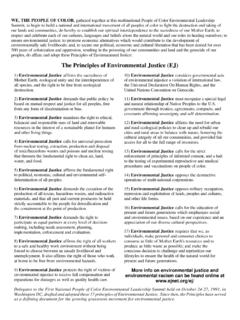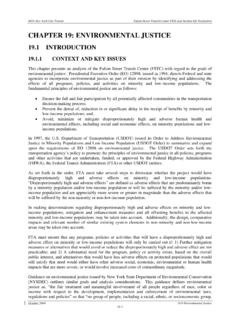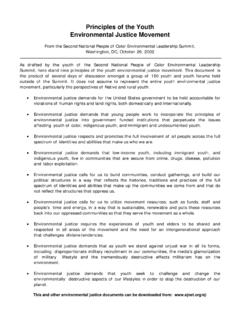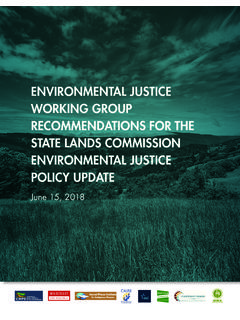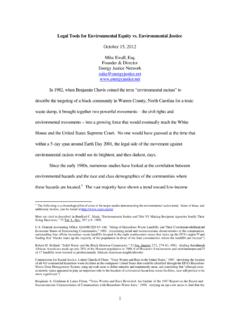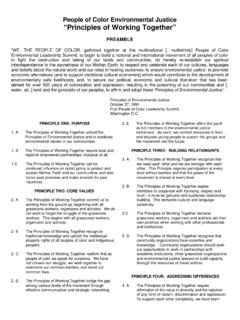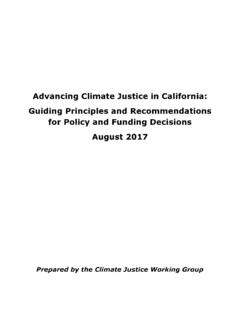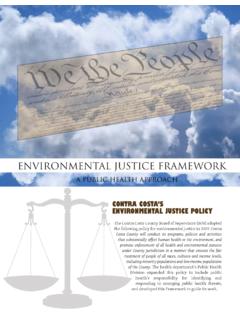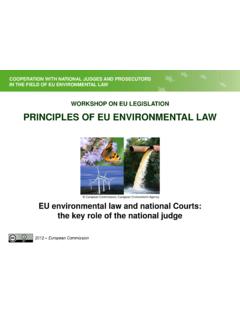Transcription of ONE SPECIES, ONE PLANET: Environmental Justice and ...
1 ONE SPECIES, ONE PLANET: Environmental Justice and Sustainable Development Center for International Environmental Law (CIEL) Washington, DC, USA October 2002 Final Edition In December 1984 in Bhopal, India, a toxic cloud of deadly methyl isocyanate was released from a Union Carbide chemical plant, an incident that, to date, has resulted in thousands dead and many more injured. Eighteen years after the disaster, people are still suffering severe health effects and have not been adequately compensated. The name Cancer Alley refers to the area along the Mississippi River between Baton Rouge and New Orleans, Louisiana, USA. Here, over a hundred chemical and oil companies have set up along the river, often near poor and/or minority communities. Residents in these areas suffer disproportionate exposure to the Environmental hazards that come with living near chemical waste. Cases of rare cancers are reported in these communities in numbers far above the national average.
2 In Nigeria s Ogoniland, Shell Petroleum Development Corporation continues to reap profits from oil exploration almost none of which reach the local peoples who instead suffer from oil spills, contamination of drinking water supplies, erosion of land, adverse health effects, and I. LINKING SUSTAINABLE DEVELOPMENT AND Environmental Justice Sustainable Development Sustainable development has become a key obligation and aspiration in various national and international legal instruments. It is the international community s agreed-upon goal for improving human well-being and Environmental management. Sustainable development is often invoked as a means for reconciling important objectives that might 1 For more information, see: sometimes appear to compete. These include respect for human rights, promotion of socially and environmentally sustainable economic growth, and protection and wise use of the natural environment.
3 Paragraph 6 of the 1995 Copenhagen Declaration on Social Development expresses these interconnections. It states: We are deeply convinced that economic development, social development and Environmental protection are interdependent and mutually reinforcing components of sustainable development, which is the framework for our efforts to achieve a higher quality of life for all people..2 Despite the Copenhagen Declaration s advance in defining the term, sustainable development frequently means different things to different people. One of the most oft-quoted definitions is from Our Common Future (also known as the Brundtland Report), which defines sustainable development as development that meets the needs of the present without compromising the ability of future generations to meet their own needs. 3 In addition to policy integration and concern for future generations, the Brundtland Report s vision of sustainable development contains within it two other key concepts: the concept of needs, in particular, the essential needs of the world s poor to which overriding priority should be given; and the idea of limitations imposed by the state of technology and social organization on the environment s ability to meet present and future needs.
4 4 Some argue that sustainable development should also include the following components: efficient resource allocation to meet basic human needs; equitable and just allocation of resources and benefits arising from their use; ecological sustainability maintaining the long-term viability of supporting ecosystems; social sustainability fulfilling people s cultural, material, and spiritual needs in equitable ways; increased accountability in institutions of governance; increased and meaningful public participation; strengthening of local democracy; focus on Environmental rights; economic viability; and finally, greater sensitivity to conditions in the Global The concept of sustainable development described in the proceedings of a 1999 Seminar of the Organisation for Economic Co-operation and Development (OECD) on Social and 2 Copenhagen Declaration, World Summit on Social Development, 1995, Copenhagen, Denmark, Doc (1995), available at 3 World Commission on Environment and Development (WCED), Our Common Future, 3 (Oxford University Press, 1987).
5 4 Id. at 43. 5 For more information, see: 2 Environmental Interfaces focuses on the quality of human life now and in the future. The report stressed: If the primary goals of environmentally sustainable development are freedom from poverty, secure livelihoods, good health and quality of life, then socially responsible development has to deal with such needs as food, basic housing, access to good water, health care (especially for children and older members of society), sanitation, education, energy in the form of fuel, transport, According to the World Conservation Union, sustainable development means achieving a quality of life (or standard of living) that can be maintained for many generations because it is: socially desirable, fulfilling people s cultural, material, and spiritual needs in equitable ways; economically viable, paying for itself, with costs not exceeding income.
6 And ecologically sustainable, maintaining the long-term viability of supporting Environmental protection is now perceived as an essential part of the process of socio-economic development and an integral feature of international law. International Environmental law, in particular, has elaborated various rules and principles for promoting sustainable development. These norms are codified in conventions, guidelines, and declarative texts. Use of the term sustainable development in these instruments has enriched legal and policy dialogue and in some respects, has modified responsibilities and Article 1 of the Convention on Biological Diversity (CBD), for example, promotes conservation along with sustainable utilization and equitable sharing of benefits derived from the use of biological resources.
7 Operational regulations of the United Nations Commission on Human Rights, United Nations Environment Programme (UNEP), United Nations Development Programme (UNDP), World Bank, Inter-American Development Bank, United States Agency for International Development, and other multilateral and bilateral institutions concerning tropical forestry, involuntary resettlement, and indigenous peoples, have also begun to emphasize a sustainability approach with a strong Environmental component. 6 OECD Seminar Social and Environmental Interface Proceedings, ENV/EPOC/GEP (99) 13, (September 22-24, 1999), available at (99)13 [hereinafter OECD Seminar]. 7 IUCN-World Conservation Union, Guide to Preparing and Implementing National Sustainable Development Strategies and Other Multi-sectoral Environment and Development Strategies, prepared by the IUCN s Commission on Environmental Strategies Working Group on Strategies for Sustainability, the IUCN Secretariat and the Environmental Planning Group of the International Institute for Environment and Development, pre-publication draft, 1993.
8 8 Gregory Maggio and Owen J. Lynch. Human Rights, Environment, and Economic Development: Existing and Emerging Standards in International Law and Global Society, report prepared for the Earth Council, Costa Rica and the World Resources Institute (1996), available at 3 Various efforts aimed at addressing Environmental degradation now accord significance to socio-economic concerns. This transformation in thinking is reflected in documents arising out of the United Nations Conference on Environment and Development (UNCED), the North American Agreement on Environmental Co-operation, the United Nations Convention to Combat Desertification, and a host of guidelines, action plans, and legal documents of the various United Nations organizations and other institutions. All mainstream definitions of sustainable development share three characteristics.
9 First, achieving sustainable development requires integrating policies related to social Justice , Environmental protection, and economic development. Second, the interests of future generations must be taken into account. And third, transparency and public participation at all levels of decision-making, from local to global, are essential to achieving sustainable development. The international community has recognized these characteristics, for instance, at the 1995 World Summit on Social Development9 and at the 1992 United Nations Conference on Environment and Environmental Justice Environmental Justice has often been defined with reference to the right to a safe, healthy, productive, and sustainable environment for all, where environment is considered in its totality, including ecological (biological), physical (natural and created by human labor), social, political, aesthetic, and economic conditions.
10 The term implies that Environmental injustice exists and highlights the need for socio-political initiatives to address these problems. That Environmental Justice has an economic aspect is clear both from the fact that it must be achieved in the context of environmentally sustainable economic activity and from international instruments such as the 1995 Copenhagen Declaration, in which the second and third sentences of Paragraph 6 state: Equitable social development that recognizes empowering the poor to utilize Environmental resources sustainably is a necessary foundation for sustainable development. We also recognize that broad-based and sustained economic growth in the context of sustainable development is necessary to sustain social development and social Justice . 11 For Environmental Justice to be attained, five basic principles should be adhered to: A disproportionate burden of protecting the environment should not be borne by any particular group, especially not vulnerable populations; The benefits of Environmental protection, such as clean water and clean air, should be equally available to all; 9 See generally Copenhagen Declaration supra note 2.


